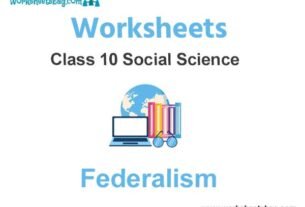Refer to Case Study Chapter 4 Quadratic Equation Mathematics, these class 10 maths case study based questions have been designed as per the latest examination guidelines issued for the current academic year by CBSE, NCERT, KVS. Students should go through these solves case studies so that they are able to understand the pattern of questions expected in exams and get good marks.
Chapter 4 Quadratic Equation Mathematics Case Study Based Questions
I. Water Distribution System: Delhi Jal Board (DJB) is the main body of the Delhi Government which supplies drinking water in the National Capital Territory of Delhi. Distribution system is well knit and properly planned. Maintenance of underground pipe and hose system is also performed at regular interval of time. Many rivers and canals are inter-connected in order to ensure un-interrupted water supply. It has been meeting the needs of potable water for more than 16 million people. It ensures availability of 50 gallons per capita per day of pure and filtered water with the help of efficient network of water treatment plants and pumping stations.
In our locality, DJB constructed two big reservoir labelled as Reservoir–A and Reservoir–B.
Reservoir–A: In order to fill it, department uses two pipes of different diameter.
Reservoir–B: Department uses two taps to store water in this reservoir.
Refer to Reservoir-A
Question. Two taps running together can fill the reservoir in 3 , 1/13 minutes. If one tap takes 3 minutes more than the other to fill it, how many minutes each tap would take to fill the reservoir?
(a) 12 min, 15 min
(b) 6 min, 9 min
(c) 18 min, 14 min
(d) 5 min, 8 min
Answer
D
Question. Two pipes running together can fill a reservoir in 6 minutes. If one pipe takes 5 minutes more than the other to fill the reservoir, the time in which each pipe would fill the reservoir separately is
(a) 8 min, 6 min
(b) 10 min, 15 min
(c) 12 min, 16 min
(d) 16 min, 18 min
Answer
B
Question. If two tapes function simultaneously, reservoir will be filled in 12 hours. One tap fills the reservoir 10 hours faster than the other. The time that the second tap takes to fill the reservoir is given by
(a) 25 hrs
(b) 28 hrs
(c) 30 hrs
(d) 32 hrs
Answer
C
Question. Two water taps together can fill a reservoir in 9,3/8 hours. The tap of larger diameter takes 10 hours less than the smaller one to fill the reservoir separately. The time in which each tap can separately fill the reservoir will be
(a) 15 hrs, 25 hrs
(b) 20 hrs, 22 hrs
(c) 14 hrs, 18 hrs
(d) 18 hrs, 16 hrs
Answer
4
Question. Two pipes running together can fill the reservoir in 11, 1/9 minutes. If one pipe takes 5 minutes more than the other to fill the reservoir, the time in which each pipe alone would fill the reservoir is
(a) 10 min, 12 min
(b) 25 min, 20 min
(c) 15 min, 18 min
(d) 22 min, 28 min
Answer
B
II. A Hill Station: In the last summer, I enjoyed a tour to a hill station at Shimla. I was accompanied by my five friends and enjoyed the natural beauties of mountains, rivers, streams, forests etc. The beginning of the tour was the most adventurous itself! How amazingly my group win the bet! Actually, the story is that my two friends along with me prefered train to go to Shimla, but other three were forcing for a car or a bus. At last the consensus was reached and we were divided ourselves in two groups of 3 each and started for Shimla at the same time. It was decided that the group who reach the destination first, would be declared as the winner, and runner up the group have to bear the expanses of the tour. I named my group, ‘Group A’ while the second group was named as ‘Group B’. Luckily we reached Shimla 1 hour before the Group-B and enjoyed the trip for absolutely FREE!! How thrilling it was the tour!
Question. An express train makes a run of 240 km at a certain speed. Another train whose speed is 12 km/hr less takes an hour longer to make the same trip. The speed of the express train will be
(a) 60 km/h
(b) 50 km/h
(c) 65 km/h
(d) 48 km/h
Answer
A
Question. A bus travels a distance of 300 km at a uniform speed. If the speed of the bus is increased by 5 km an hour, the journey would have taken two hours less. The original speed of the bus will be
(a) 20 km/h
(b) 15 km/h
(c) 22 km/h
(d) 25 km/h
Answer
D
Question. An express train takes 1 hour less than a passenger train to travel 132 km between Delhi and Shimla (without taking into consideration the time they stop at intermediate stations). If the average speed of the express train is 11 km/hr more than that of the passenger train, the average speeds of the two trains will be
(a) 33 km/h, 44 km/hr
(b) 40 km/h, 45 km/h
(c) 30 km/h, 38 km/h
(d) 42 km/h, 62 km/h
Answer
A
Question. A deluxe bus takes 3 hours less than a ordinary bus for a journey of 600 km. If the speed of the ordinary bus is 10 km/hr less than that of the deluxe bus, the speeds of the two buses will be
(a) 35 km/h, 42 km/h
(b) 42 km/h, 52 km/h
(c) 40 km/h, 50 km/h
(d) 30 km/h, 58 km/h
Answer
C
Question. A journey of 192 km from Delhi to Shimla takes 2 hours less by a super fast train than that by an ordinary passenger train. If the average speed of the slower train is 16 km/hr less than that of the faster train, average speed of super fast train is
(a) 50 km/h
(b) 48 km/h
(c) 55 km/h
(d) 60 km/h
Answer
B


